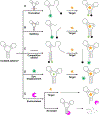Advances and Challenges in Small-Molecule DNA Aptamer Isolation, Characterization, and Sensor Development
- PMID: 33559947
- PMCID: PMC8292151
- DOI: 10.1002/anie.202008663
Advances and Challenges in Small-Molecule DNA Aptamer Isolation, Characterization, and Sensor Development
Abstract
Aptamers are short oligonucleotides isolated in vitro from randomized libraries that can bind to specific molecules with high affinity, and offer a number of advantages relative to antibodies as biorecognition elements in biosensors. However, it remains difficult and labor-intensive to develop aptamer-based sensors for small-molecule detection. Here, we review the challenges and advances in the isolation and characterization of small-molecule-binding DNA aptamers and their use in sensors. First, we discuss in vitro methodologies for the isolation of aptamers, and provide guidance on selecting the appropriate strategy for generating aptamers with optimal binding properties for a given application. We next examine techniques for characterizing aptamer-target binding and structure. Afterwards, we discuss various small-molecule sensing platforms based on original or engineered aptamers, and their detection applications. Finally, we conclude with a general workflow to develop aptamer-based small-molecule sensors for real-world applications.
Keywords: DNA; SELEX; aptamers; biosensors.
© 2021 Wiley-VCH GmbH.
Conflict of interest statement
Conflicts of interest
The authors declare no conflicts of interest.
Figures





References
-
- Nguyen VT, Kwon YS, Gu MB, Curr. Opin. Biotechnol 2017, 45, 15–23. - PubMed
-
- Metkar SK, Girigoswami K, Biocatal. Agric. Biotechnol 2019, 17, 271–283.
Publication types
MeSH terms
Substances
Grants and funding
LinkOut - more resources
Full Text Sources
Other Literature Sources

